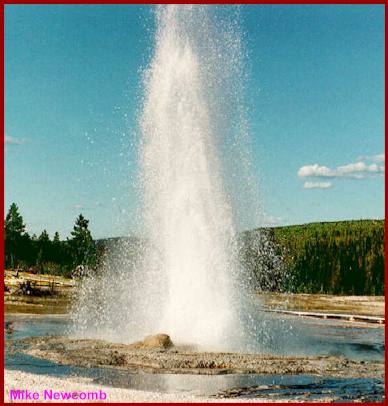
Biscuit Basin
Biscuit Basin: - Map
Biscuit Basin can be reached by road or by trail. There are a number of small and interesting geysers in this basin. the main group of the basin is traversed by a short boardwalk.
Jewel Geyser: [Pictures] [Map]
[Jewel Geyser description provided by Ralph Taylor.]
Jewel Geyser has long been considered the major geyser of the Main Group of Biscuit Basin. Originally named Soda Geyser by the Hayden Survey, the name was changed to Jewel Geyser by Hague in 1887. For all of its known history, Jewel has been a regular, frequent performer. The only known exception was a period of steady spouting following the 1959 Hebgen Lake earthquake.
Jewel Geyser is located at the top of the boardwalk hill from the Biscuit Basin parking lot, past Sapphire Pool and the junction of the boardwalk loop. Jewel erupts from a nearly circular sinter shield about 10 meters in diameter. There is an irregular crater in the form of a long narrow basin with the long axis running generally north to south. The inner part of the formation is a smooth appearing sinter mass surrounding the inner crater. The outer part of the sinter shield consists of sinter lumps and nodules, terminating in a ring of sinter sand. The outer limits of the splashing of the eruptions is clearly marked by larger sinter nodules. The outer portion of the sinter shield is convoluted and covered by small sinter knobs, perhaps the jewels for which the geyser was named.
For years, Jewel erupted from a full pool. The eruption cycle began with a gradual rise in the water level. The water gradually rose until the sinter knobs near the vent were nearly submerged. The water then welled up rapidly; surging and doming over the vent for a minute or two before the start of the eruption. The eruption itself began with a sudden jet of water bursting upwards at an angle to the southwest. The eruptions consisted of from one to eight short bursts, each lasting from three to eleven seconds, separated by five to fifteen seconds. The bursts reached anywhere from two to ten meters in height. The bursts were small (staying in the inner crater), medium (landing on the inner sinter splash pan), or large, landing on the gravel surrounding the splash pan.
In recent years, the eruptions of Jewel Geyser have started from low pool, with almost no warning. The number of bursts per eruption has been much more consistent, ranging from 5 to 9, with most eruptions having 7 or 8 bursts. The bursts are larger, almost all of them medium or large, some huge, reaching the undisturbed sinter sand surrounding the platform. Eruption intervals were more consistent also, mostly in the 8 to 9 minute range.
There have been reports that Jewel is erupting from a full pool since the earthquake in the Biscuit Basin vicinity in January 1998.
Rusty Geyser: [Pictures] [Map]
Rusty Geyser is probably the easiest geyser to see in Yellowstone. Not only is it frequent, erupting as little as every one to four minutes or less, but it is also located right next to the entrance road to the Biscuit Basin parking lot, so you can watch it from your car if the mood strikes you.
Rusty is a small cone-type geyser. Intervals are frequently in the one to four minute range but at times have been seen to extend to as much as 13 minutes. Durations range from 10 to 45 seconds. The maximum height is about 6 feet, though 10 feet has occasionally been seen.
Rusty was reportedly named for the rust colored sinter around its vent.
What to look for:
You can easily watch the typical geyser eruption cycle at Rusty. Prior to the eruption, the water rises in the vent begins to overflow and splash a little. The splashing builds into an eruption. After the eruption, the water drains away leaving the vent empty.
[ Geyser Hill Group - Map ] [ Old Faithful
Area - Map ]
[ Castle
Group - Map ] [ Sawmill Complex - Map ] [ Grand Group
- Map ]
[ Grotto Group - Map ] [ Daisy
Group - Map
] [ Giant Group - Map ]
[ Riverside/Morning Glory
Group - Map
] [ Old Road
Group - Map ]
[ Black Sand Basin - Map ]
Comments and Questions are Welcome
This Page is hosted by Geocities.